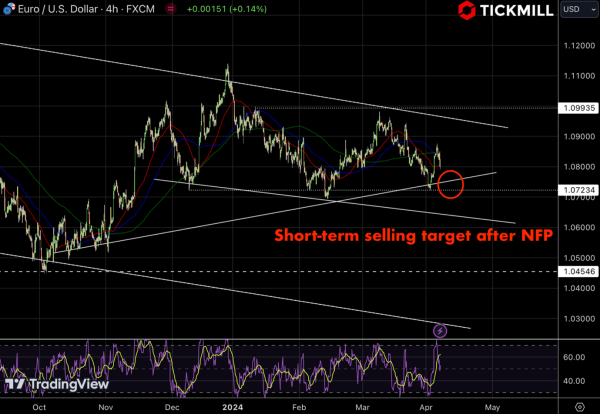NFP Shakes Up Markets, EUR/USD Takes a Tumble
Today, the spotlight shines on the EUR/USD pair as it takes a plunge, breaching the 1.0800 mark on Friday. The downturn has been triggered by the release of US Nonfarm Payrolls data, which exceeded expectations by a wide margin:

The data unleashed a wave of surprises, revealing that the US economy flexed its muscles by adding a whopping 303,000 new jobs in March. Economists, in their forecasts, had anticipated a more modest addition of 200,000. As if that wasn't enough, February's employment figures were revised downward, adding another layer of intrigue to the mix.
Delving deeper into the report, there are other indications that the strength of the US labor market persists. The US Unemployment Rate dipped to 3.8% from its previous standing of 3.9%. Such resilience in the job market paints a vivid picture of the US economy's robustness.
The implications are far-reaching. With the economy showing no signs of slowing down, inflation is poised to maintain its stubbornly high trajectory. This development substantially diminishes the likelihood of the Federal Reserve (Fed) cutting interest rates come June, a move that had been previously anticipated by market watchers.
Average Hourly Earnings remained stagnant, reflecting a year-over-year increase of 4.1% and a month-over-month uptick of 0.3%, it underscores the steady growth in wages, a factor that demands attention amidst the broader economic landscape.
Before the NFP release, the EUR/USD pair had already been feeling the heat, courtesy of discouraging German Industrial Orders data. A steep decline of 10.6% in February set alarm bells ringing, serving as a stark contrast to January's 6.2% downturn. Despite a modest uptick in German Factory Orders, missing economists' estimates, the recovery was still seen as tepid.
Adding fuel to the fire, rising tensions in the Middle East have propelled the price of oil above the $90 per barrel mark, a development with ominous implications for inflation. The chorus advocating for elevated interest rates gains momentum, echoing sentiments expressed by Minneapolis Federal Reserve Bank President Neel Kashkari, who hinted at the possibility of no rate cuts in 2024 if inflation persists at its current levels.
This narrative bodes well for the US Dollar, which stands to benefit from increased foreign capital inflows. Meanwhile, across the pond, a consensus seems to be forming among Eurozone rate-setters regarding a proposed interest-rate cut in June, exerting downward pressure on the Euro (EUR).
The Pound Sterling (GBP), not to be left out of the equation, experienced a sharp decline to 1.2600 during Friday's early American session. Blame it on the upbeat NFP data from the United States, which has bolstered demand for the US Dollar.
In the United Kingdom, easing inflation expectations cast a shadow over the Pound Sterling. The latest Bank of England (BoE) Decision Maker Panel (DMP) survey for February paints a picture of cooling selling prices and wage inflation, raising the specter of early rate cuts by the BoE and weighing down on the Pound Sterling.